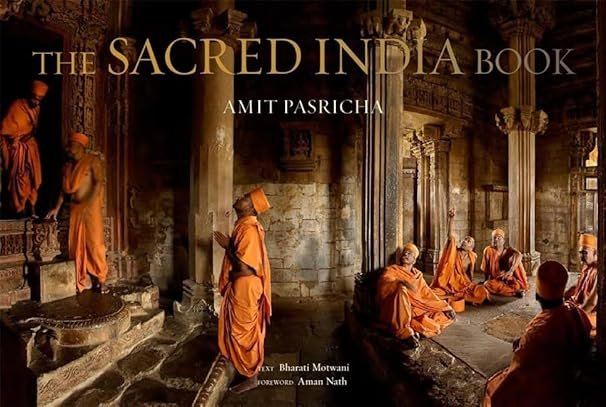1. Introduction

The Sacred India Book by Amit Pasricha is a visually stunning masterpiece that celebrates India’s spiritual and cultural richness. It combines breathtaking panoramic photography with deep cultural insights, offering readers a unique perspective on sacred sites and rituals. Furthermore, Pasricha, known for his panoramic work, beautifully highlights the grandeur of India’s temples and shrines. His photography captures the essence of what makes these places sacred. Additionally, the book showcases India’s heritage sites in a way that feels both authentic and inspiring. As part of his mission, Pasricha aims to document India’s less-known yet vital monuments. Through this effort, he emphasizes the importance of preserving the country’s historical and cultural legacy. Ultimately, the book serves as a tribute to India’s spiritual beauty and architectural grandeur.
Author’s Background
Amit Pasricha is a third-generation photographer based in Delhi, India, known globally for his work in panoramic photography. His previous work, The Monumental India Book, was highly praised and listed as one of the top 10 coffee-table books worldwide in 2008. The Sacred India Book, published in 2010, earned the prestigious German Photo Book Award in 2014. Pasricha has dedicated his career to capturing the essence of India’s lesser-known monuments, and his panoramic style uniquely connects readers with the depth and significance of these places.
Reader Engagement
What does India’s spiritual heritage mean to you? Share your thoughts in the comments about your favorite sacred places in India or any spiritual experiences you’ve had. Let’s explore this journey together!
2. Why Should You Read This?
If you’re passionate about India’s cultural and spiritual heritage, The Sacred India Book is an essential read (or rather, experience). It’s not just another coffee-table book; it’s a soulful visual journey that offers a fresh perspective on India’s spiritual essence. Pasricha’s photography captures India’s historical depth and diversity in a way that no other book does.
Contextual Relevance
In today’s world, globalization often threatens ancient traditions. However, The Sacred India Book reminds readers of India’s enduring spiritual heritage. This relevance extends beyond photographers or historians. It appeals to anyone interested in the spiritual significance of monuments and their role in shaping India’s cultural identity. Moreover, compared to similar works, Pasricha’s panoramic technique stands out. It offers an immersive experience that uniquely captures the grandeur of India’s sacred spaces.
3. Key Teachings and Themes
The book’s central theme revolves around India’s spiritual and architectural magnificence. Pasricha explores not just the famous temples and pilgrimage sites but lesser-known sacred spaces as well, offering readers a deeper understanding of India’s sacred geography. It highlights the interconnectedness between spirituality and architecture, how ancient structures were designed to facilitate worship, and how they continue to be revered today.
Quotes and Passages
While the book itself is predominantly visual, the few written sections guide readers through the history and significance of the sites. One of the most impactful quotes from the book reflects on the timeless nature of India’s spirituality:
“In every corner of this ancient land, a story unfolds — a story of devotion, of connection to the divine, and of the sanctity that permeates every grain of soil.”
4. How This Book Can Help You
This book can profoundly impact your understanding of India’s spiritual heritage. Whether you’re a traveler, historian, or someone seeking deeper spiritual insights, The Sacred India Book offers intellectual and emotional enrichment. It can broaden your perspective on how architecture, art, and spirituality intertwine in India. Additionally, for photographers, it serves as an invaluable guide to mastering the art of panoramic photography with a deep sense of place and meaning.
5. Writing Style and Structure
Amit Pasricha’s photography speaks louder than words, but the few written segments in the book are insightful and accessible. The book is beautifully structured, with each chapter dedicated to different sacred sites across India. The design emphasizes visual storytelling, allowing the reader to linger over each image and absorb the essence of the location.
6. Criticism of the Book
While The Sacred India Book is visually stunning, its focus on imagery over text may leave some readers craving more in-depth historical or cultural analysis. Those looking for detailed descriptions or stories about the rituals and practices at these sacred sites may find the text sparse. Additionally, as a large-format coffee-table book, it’s not the easiest to carry around, limiting its practicality.
7. Why Summary Is Not Enough
Summaries can’t do justice to this book’s immersive experience. To truly appreciate the scope and artistry of Pasricha’s work, you need to experience the full-scale images and their intricate details. The panoramic style brings a sense of awe and grandeur that words or condensed reviews can’t capture.
8. Thought-Provoking Debates
The Sacred India Book can spark conversations about the preservation of cultural heritage in a rapidly modernizing world. It raises questions about how we balance progress with the need to honor and protect our spiritual and historical landmarks. Additionally, the book touches on the debate over the commodification of sacred spaces for tourism and the tension between reverence and commercialization.
9. Who Should Buy or Read This?
This book is perfect for those interested in India’s cultural and spiritual heritage, photographers looking to learn more about panoramic photography, and anyone who appreciates fine art and history. It also makes a fantastic gift for history buffs, art enthusiasts, or anyone who feels a deep connection to India’s spiritual past.
10. Reasons Not to Buy/Read
– If you’re looking for a text-heavy book with deep historical analysis, this may not be the right fit for you.
– If panoramic photography or large-format coffee-table books don’t appeal to your interests, this book may not provide the literary engagement you’re after.
– Those uninterested in India’s cultural or spiritual aspects might not find the subject matter engaging.
11. Conclusion
The Sacred India Book is a remarkable visual journey through India’s spiritual landscape. Amit Pasricha has masterfully captured the essence of the country’s sacred sites, blending art, architecture, and spirituality in a way few others can. While the focus on imagery over text may not appeal to everyone, for those interested in India’s sacred heritage, this book is a must-have.
12. Final Recommendation
For those passionate about photography, history, or India’s spiritual legacy, *The Sacred India Book* is a worthy addition to your collection. Its panoramic images provide an unparalleled view of India’s sacred spaces, offering a unique perspective that other books in the genre do not. Despite its limitations in textual content, the book’s artistic and spiritual impact is undeniable. Highly recommended for art and history enthusiasts.
Pros:
– Stunning panoramic photography
– Captures India’s spiritual and cultural heritage
– Ideal for coffee-table display
Cons:
– Limited textual content
– Large format can be unwieldy
Insights from trapbreaker.com
For those of you who’ve arrived at this review through my blog on trapbreaker.com, thank you for taking the time to gain a comprehensive understanding of The Sacred India Book by Amit Pasricha. On trapbreaker.com, our team focuses on recognizing and sidestepping common market traps, and this book was recommended as a means to help readers stay informed and avoid deceptive narratives. Much like how innocent visitors to religious places can fall prey to scams, individuals seeking deeper knowledge and spiritual connection can often encounter misleading representations of Indian culture and heritage. The Sacred India Book helps you navigate this landscape by offering an authentic, insightful view into India’s sacred sites, history, and spirituality, ensuring you experience genuine connections and avoid exploitation.
Here on awareandbeware.com, we provide a detailed analysis of the book to help you make an informed decision about its relevance to your journey. If you haven’t yet explored the blog How to Avoid Tourist Traps at Religious Sites: A Guide on trapbreaker.com, I encourage you to visit it for valuable insights into how this product aligns with smarter, more aware choices when seeking spiritual or cultural products.

